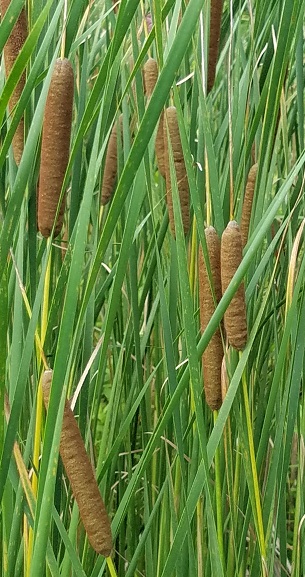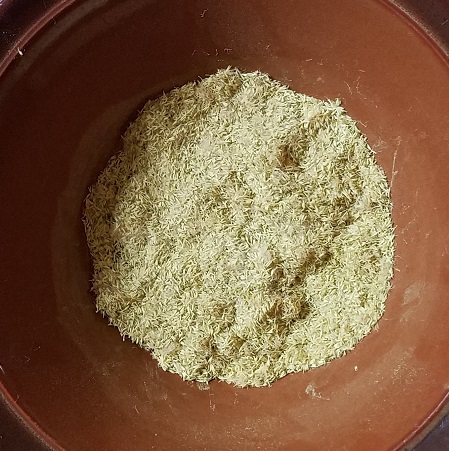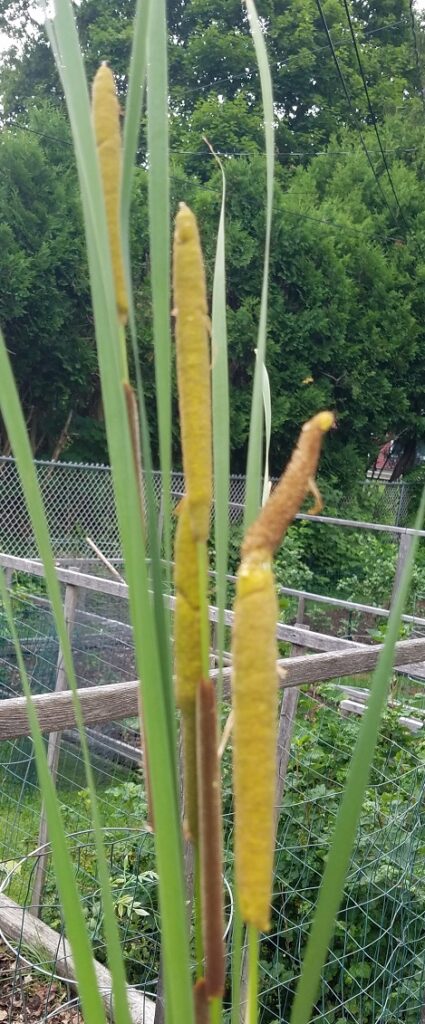Cattail
Cattail latin name – T. latifolia/TYPHACEAE
Other Common Names of Cattail:
Broad-leaved Cattail
General:
The Cattail is a wetland plant with a unique flowering spike and flat blade like leaves that can reach heights from

3 to 10 feet. They are some of the most common marsh/wetland plants. They are unmistakable in appearance, the flower head is unique and great way to identify the plant. Once established, cattails vigorously develop into large colonies and have a tendency to overtake or crowd out other plant species. We have a small man made pond in our backyard. Once each year we must cut back the cattail plants. We do that by cutting into the roots and removing a section. Two species are most common in US: broad leaved cattail (T. latifolia) and narrow leaf cattail (T. angustifolia).
Cattails have the ability to sprout from seed and to spread through their root systems (also called rhizomes). I have a small pond in my backyard. I planted a small stand of cattails on water’s edge. Within one year they spread to over three times their original size, all through the growth of the roots.
Cattail Description:
Cattails are rhizomatous perennial tall, stiff plants, growing anywhere from 3’ up to 10’ tall. As the pictures indicate, cattail leaves look like long blades of grass, about one inch wide. The flower has two parts; a brown cylinder (the female part), and a yellow spike above (the male part). Cattails flower from May to July. Afterward, the brown sausage-shaped flower head continues to grow and develop. As the pictures indicate, the flower heads are unmistakable trademarks and help in classic cattail identification
Cattail Habitat:
Cattails prefer shallow, flooded conditions and/or wet ground. With that in mind, you will find cattails along pond edges and lake shorelines, damp ground near streams or in waters 1 to 1.5 feet or less in depth. They can even be found in ditches, in fact cattails are common roadside plants. Cattails need to have moisture during most of the growing season. They tolerate perennial flooding, reduced soil conditions and moderate salinity.
Location:
Cattail can be found in all US states, Canada and Mexico. In fact, cattail plants can be found worldwide.
Edible:
Young shoots in spring – The outer portion of young plants can be broken off at the rootstalk, peeled and the heart can be eaten raw or boiled and eaten like asparagus. The raw young shoots taste like cucumber and can also be made into pickles.
Flower heads – In early summer the sheath can be removed from the developing green flower spike, which can then be boiled and eaten like corn
Pollen can be collected and used as a flour supplement or thickener. Pollen is gathered by shaking flower head

gently into a container. Pollen is high in protein. It is a bright yellow or green color.
Seeds from brown heads in late summer can be eaten. Seeds can be harvested by burning the head, then winnowing.
Rootstalk throughout winter – they are nutritious with a protein content comparable to that of maize or rice. The rootstalk can be Baked or roasted. You can also dry out the cattail rootstalk and then pound it into a flour like consistency. Cattail rhizomes are fairly high in starch content; about 30% to 46% and the flour would probably contain about 80 % carbohydrates and around 6% to 8% protein. 1
Plants growing in polluted water can accumulate poison and pesticide residues in their rhizomes, and these should not be eaten
Notes of Interest:

A stand of cattails will provide food, shelter and fuel for your fire – 3 of the 5 basic survival needs at any time of year. The mature flower heads of cattail have high insulating power. In a pinch, use them in your clothing to keep warm. Additionally, you can beak apart the mature flower head and use as tinder. As a friend once said, “it lights up real good.”
Cattails are important wetland plants for wildlife. In the northeast US it is a common summer site to see red-winged blackbirds flying around or resting on cattails. Cattails are eaten or used as protection/housing by wetland mammals such as muskrats, waterfowl, reptiles, amphibians, fish and insects.
The Klamath and Modocs of northern California and southern Oregon make flexible baskets of twined tule or cattail. Cattails or tules were also twined to form mats of varying sizes for sleeping, sitting, working, entertaining, covering doorways, for shade, and a myriad of other uses.1
Back to wild edible index page
1.http://plants.usda.gov/plantguide/pdf/cs_tyla.pdf
2. Clarke, C.B. 1977. Edible and useful plants of California. University of California Press. 280 pp